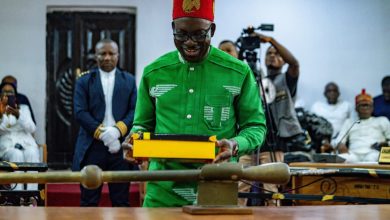
By Ejike Abana
On November 19, 2024, Governor Chukwuma Charles Soludo, CFR, stood before the Anambra State House of Assembly and presented the 2025 budget—aptly titled **“Changing Gears 2.0.” This budget proposal marked a decisive step in pursuing the administration’s ambitious agenda for economic transformation and social development. With a modest but significantly ambitious figure of **₦606.99 billion**, up 48% from ₦410 billion in 2024, the budget set the tone for accelerated growth driven by capital investment.
Governor Soludo outlined the structure of the 2025 budget: recurrent expenditure accounted for ₦139.5 billion—a 45% year-on-year increase—while capital expenditure rose even more sharply, by 48.9% to ₦467.5 billion. Importantly, the budget deficit was prudently projected at ₦139.5 billion or 24% of the total budget, showing a responsible narrowing compared to 30% in 2024.
Despite a challenging macroeconomic environment marked by persistent double-digit inflation and pressures on governance costs, the administration pushed through, achieving above 60% pro-rata budget performance even in an election year. The revenue picture was mixed: internally generated revenue (IGR) showed year-on-year improvements but lagged projections, while federal allocations fell short of expectations. Nonetheless, execution remained resolute.
*Changing Gears Again: The 2026 Budget Proposal – Solution Continues*
Fast forward to the present, and Governor Soludo unveils the 2026 budget proposal, an assertive financial blueprint with a promising title: **“Changing Gears 3.0: Solution Continues.”**
Reflecting his administration’s unwavering commitment, the 2026 budget pinpoints to an even deeper resolve to drive impactful execution.
The proposed fiscal size for 2026 is **₦757.89 billion**, reflecting a **24.1% increase** over the 2025 budget. This upward adjustment mirrors intensified focus on delivering tangible results and accelerating Anambra’s development trajectory. Breakdown of the new budget reveals recurrent expenditure projected at ₦162.6 billion—a 16.6% increase from 2025—while capital expenditure surges to ₦595.3 billion, rising 26.3%. Notably, capital expenditure accounts for a staggering 79% of the budget, leaving recurrent expenditure at only 21%, affirming the government’s strong preference for investment-led growth over consumption.
Budget financing remains conservative, with a deficit of ₦225.7 billion (29.8%), but the Soludo-led administration continues to reject borrowing for consumption or frivolity. Instead, as aptly out by the Governor, future deficits will be bridged through “hybrid financing” such as privatization proceeds, better IGR performance, and concessionary borrowing for projects with clear, quantifiable returns. Since taking office, Governor Soludo’s government has avoided borrowing to plug deficits, consistently demonstrating fiscal discipline.
*Strategic Priorities Reflect Bold Vision and Pragmatism*
The 2026 budget rings with thematic consistency. Year-on-year sectoral spending increases highlight priorities:
– Administrative Sector (+12.2%)
– Economic Sector (+26.7%)
– Social Sector (+31.4%)
– Education (+46.9%)
– Health (+13%)
– Infrastructure Investments (+27.7%)
At least 70% of the budget targets the pillars of security, infrastructure, economic transformation, and human capital development—cornerstones of the Anambra Dubai Taiwan Silicon Valley (ADTS).
The budget reflects that transport infrastructure remains a flagship focus. Beyond building and dualizing critical roads, the administration aggressively expands mass transit with new buses, jetties, and boats for safer waterways. The Rail Master plan is progressing with public-private partnerships to bring cutting-edge transport solutions.
Also, ambitious urban development continues with the creation of three new cities: **Awka 2.0**, **Greater Niger**, and the **Aerotropolis/New Industrial-Commercial City**. The Anambra Mixed-Use Industrial City project will also launch in earnest, driving industrial transformation and urban regeneration.
Efforts to improve the Ease of Doing Business signal an investor-friendly agenda, with policy reforms aiming to attract both local and foreign investments.
*Education and Healthcare: Foundations of the Future*
Education remains a flagship social sector, with sustained investments in free, quality education and bursaries. The 2026 plan includes constructing new schools in 30 communities that never had public primary schools, upgrading existing facilities via the ASUBEB programme, and establishing two specialist tertiary institutions to elevate higher education standards. Government collaboration with mission schools will deepen through a new committee working to support their sustainability.
Healthcare investments continue apace, with plans to complete the College of Nursing and a specialist teaching hospital focused on oncology. Renovations and equipping of primary and secondary healthcare facilities will persist, improving healthcare access and quality statewide.
*Empowering Youth, Supporting Innovation, and Ensuring Basic Needs*
Governor Soludo’s administration aims to upscale the **One Youth, Two Skills** initiative—equipping more young people with entrepreneurial skills. Digital skills development will flourish through completion of the iconic **Solution Innovation District (SID)** and partnerships to establish Anambra as a tech and innovation hub.
Water supply expansion targets universal access to clean, reliable water for households and industries, while electricity access projects, underpinned by the recent creation of the **Anambra State Electricity Regulatory Commission (ASERC)**, pave the way for private sector-led power market development.
In addition, inclusive social safety nets are embedded in the budget, offering free education, free medical services, tax reliefs, agricultural seedlings, and grants to micro-businesses in all 326 wards — advancing the administration’s ethos of leaving no one behind.
*Responsible Fiscal Management and Partnership-Driven Growth*
Fiscal discipline remains the bedrock of Governor Soludo’s financial stewardship. Borrowing occurs strictly for concessionary loans financing revenue-generating infrastructure—not consumption. Frugality is enshrined, evidenced by the impressive 21% recurrent to 79% capital expenditure ratio.
Yet, the administration acknowledges that **Internally Generated Revenue (IGR) remains a challenge.** From all indication, a technology-driven overhaul to widen the tax base, reduce leakages, and support compliance is imminent to plug this gap.
Strong partnerships underpin progress. Collaborations with the Federal Government, private sector, international donors, and local communities multiply development impact. The 2026 budget allocates counterpart funds to leverage external grants and investments, strengthening collective action.
Governor Soludo concluded his budget address with a resounding message of gratitude and commitment, emphasizing that every kobo allocated will be stewarded with prudence and transparency. According to him, because ndị Anambra’s trust is regarded as sacred; the government and its Solution Team will remain steadfast in their mission to build a prosperous, inclusive, and smart future.
No doubt, since Governor Soludo came onboard, Anambra State’s budget trajectory reflects a state indeed on the rise. This is fiscal strategy married to vision, tenacity, and the collective will to transform aspirations into reality. Indeed, the journey continues — the gears are shifting ever faster, and Anambra is ready to accelerate into its promising tomorrow.





